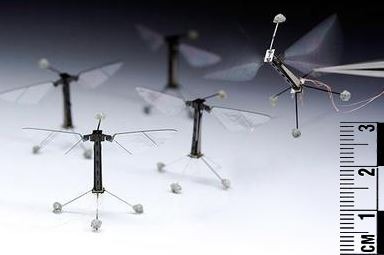The idea of tiny, fly-sized drones is aplenty, including the concept of robotic technology going wireless. This is important because these small types of robots can bring advantages for different industries across the globe. In agriculture, a small robot can help pollinate plants or help in research on how their biological counterparts fly.
However, today’s researchers have remained fascinated by the many things that RoboBees can do in search and rescue activities and environmental hazards.
Robobee, known as the world’s smallest flying robot, has the size of your fingernail. It can be tethered to a wire cable to energize its wings.
Developed at the Wyss Institute in Harvard, RoboBee is a micro-robot only 0.2mm long.
“It is powered through a special floor that contains tiny electrodes. These induce an electrical charge in the robot, enabling it to move like an inchworm,” said Dr. Peter Bentley, a London-based computer scientist, and author, in describing RoboBee’s features.
Aside from its capability to fly, the RoboBee could also carry a camera. This means that as technology continues to advance, RoboBee could also become the world’s smallest drone.
Scientists at Harvard said insects inspired them in crating the bug-sized robot.

The robot has electronic “muscles” and made of carbon fiber materials, with just a weight of a fraction of a gram. The robot has a pyramid-shaped light sensor composed of four phototransistors soldered to make a custom circuit board, allowing the tiny machine to have balance while in the air.
Despite the apprehension on how small size drones, robots, and Artificial Intelligence could pose privacy problems and questionable purposes, many scientists and researchers continue to develop tiny robots.
“With technological advances, computers are getting ever smaller enabling the creation of some miniscule robots,” Bentley added.
Other scientists also recently developed a molecular-sized nanobot.
Meanwhile, Prof. Dr. Oliver G. Schmidt, chair of the Professorship of Material Systems for Nanoelectronics at Chemnitz University of Technology, has made a breakthrough with the development of the smallest microelectronic robot in the world, which is driven and controlled by a twin-jet-engine.
“The use of this system in the areas of micro-robotics and medical technology could be envisioned for targeted administration of medication or directly diagnosing diseases within an organism. The results of this research are crucial to the development of microrobotic systems,” read a report from Nanowerk.
“The goal of this is to develop a fully controllable and steerable microelectronic robot – long considered science fiction, until now. Although there are chemically-powered micromotors that are being tested in medical studies in the US for the curing of certain illnesses, they are very simple systems that have no electrical energy or microelectronic units on board,” it added.
This other microelectronic robot is 0.8 mm wide, 0.14 mm tall, and 0.8 mm long.
This robot is highly flexible and can perform different tasks. Its system can be controlled remotely, and it can also maneuver in a water solution. Additionally, this microelectronic robot has micro robotic arm and light source.
“Almost ten years ago, my team and I came up with the idea to combine tiny chemical nozzle drives with microelectronic components, to bring together two disciplines that until then had little in common,” said Schmidt of their invention.
He also acknowledged the “technologically innovative strength” of his Ph.D. student Vineeth Kumar Bandari and the extraordinary scientific engagement of Dr. Feng Zhu.
“It can now be experimentally realized in a first, simplified form,” Schmidt said.

“We construct the microbot initially in such a way that it swims in circles if no heat is applied at all. If some heat is applied, the turning is compensated and the microbot swims in a straight line. If more heat is applied, the microrobot turns in the other direction,” Schmidt added.
The microelectronic robot was made from polymer-based nanomembranes, providing its excellent mechanical flexibility.
Its micro-arm is equipped with a system in the form of an actuator composed of a thermoresponsive polymer.
“Researchers used the principle of induction to transmit energy remotely — this is something similar to how a cell phone is charged wirelessly. Although the concept is not a new one, this is the first it has been used at the micro-scale,” said tech writer Faisal Khan.
“Science fiction has become a science fact with the development of this fully controllable and steerable microelectronic robot and this can, in fact, be a milestone for Healthtech, where the use of autonomous microbots for targeted medicinal delivery can soon become a reality,” he added.
However, for Khan, the concept of microelectronic robots still needs further improvement, considering that its current fuel used is in the form of hydrogen peroxide, which would be lethal for the human body.
The ubiquitous cockroach inspired the third among the smallest and fastest robots.
HAMR-Jr, a cockroach-inspired robot, is developed by CU Boulder engineer Kaushik Jayaram and colleagues at Harvard University. The robot weighs far less of a paperclip, but it can carry up to 10 times its own weight in cargo and flies at high speed.
“HAMR-Jr can achieve gaits that approach an animal-like mechanical dexterity, demonstrating that we do not need to compromise design complexity or manufacturability to reduce the size of our robots,” said Jayaram, an assistant professor in the Paul M. Rady Department of Mechanical Engineering.

This small machine can turn right and left and even moves backward.
“It also runs at a pace of nearly 14 of its own body lengths, or about one foot, per second. For comparison, cheetahs, the speed demons of the mammal world, sprint at roughly 16 body lengths per second,” CU Boulder narrated.
Citing Jayaram’s vision, CU Boulder said that machines the size of HAMR-Jr “could crawl into airplane engines or other spaces where mechanics can’t reach to conduct needed inspections.” This smallest-type of robot “might even perform surgeries on human patients.
“I want to build robots that can get out of the lab and run around like bugs,” Jayaram said.
“We showed that our design and fabrication methodology is highly scalable. We could shrink everything down or scale it up, and the robot would still work,” the engineer added.
Indeed, the development of RoboBees, microelectronic robot, and HAMR-Jr continue to inspire other researchers and scientists to design small robots with big promises in terms of their efficiency, purpose, and usage for the benefit of humanity.

